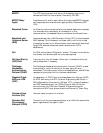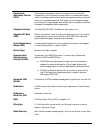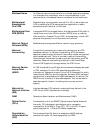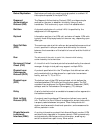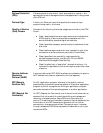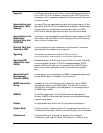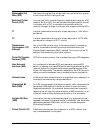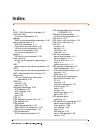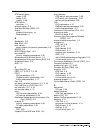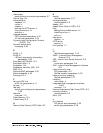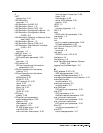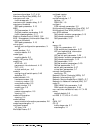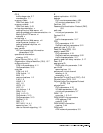
Cajun P550/P880 ATM Uplink User Guide, Version 1.1
G-11
Sustainable Cell
Rate (SCR)
Maximum throughput that bursty traffic can achieve within a given
virtual circuit without risking cell loss.
Switched Virtual
Circuit (SVC)
A virtual link, with variable endpoints, established through an ATM
network. With an SVC, the user defines the endpoints when the call
is initiated; with a PVC, the endpoints are predefined by the
network manager. A single virtual path may support multiple SVCs.
T1 A digital transmission service with a basic data rate of 1.544 Mbits
per second.
T3 A digital transmission service with a basic data rate of 44.736 Mbit
per second for transport of 28 T1 circuits.
Transmission
Convergence (TC)
Sublayer
Part of the ATM physical layer, it defines a protocol for preparing
cells for transmission across the physical media defined by the
Physical Media-dependent (PMD) sublayer. The function of the TC
sublayer differs according to physical medium.
Trivial File Transfer
Protocol (TFTP)
IETF’s file transfer protocol, that transfers files using UDP datagrams.
User Network
Interface (UNI)
An interface point between ATM end users and a private ATM
switch, or between a private ATM switch and the public carrier ATM
network; defined by physical and protocol specifications per ATM
Forum UNI documents. The standard adopted by the ATM Forum to
define connections between user or endstations and a local switch.
Unicast frame An Ethernet frame transmitted with a single destination address; it is
intended to be received by a single destination.
Unspecified Bit
Rate (UBR)
An ATM service category that does not specify traffic-related service
guarantees. UBR does not include the notion of a per-connection
negotiated bandwidth. No numerical commitments are made with
respect to the cell loss ratio experienced by a UBR connection, or as
to the cell transfer delay experienced by cells on the connection.
Variable Bit Rate
(VBR)
Information that can be represented digitally by groups of bits (as
opposed to streams) is characterized by a variable bit rate. Most data
applications generate VBR traffic, which can tolerate delays and
fluctuating throughput.
Virtual Circuit (VC) A defined route between two endpoints in an ATM network that
may traverse several virtual paths.



